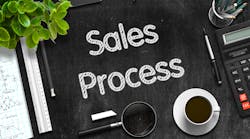Your distributorship's buyer relationships may not appear on your balance sheet, nonetheless, at many distributorships, those relationships could be more costly to replace than the firm's building or inventory. With so much of a distributor company's value tied to its buyer relationships, it's important to know how much of that relationship is portable when a salesperson defects to a competitor. Shedding new light on this topic is recent research by Robert W. Palmatier, visiting professor at Northwestern University's Kellogg School of Management. Before earning his doctorate in marketing from the University of Missouri, Palmatier was president and chief executive officer of C&K Components, the second largest U.S. manufacturer of electronic switches.
Palmatier's research on this topic was based on a study of rep companies and rep company salespeople, but his findings clearly are applicable to distributors and distributors' salespeople.
Palmatier allowed Prime Devices Corp.'s president, Charles M. Cohon, to preview a paper being readied for publication in an academic journal and to synopsize it for the readers of Electrical Wholesaling. Much of the material in this article appeared recently in Agency Sales magazine. Along with managing his Morton Grove, Ill.-based rep agency, Cohon is author of “The Sales Force.”
When companies invest in activities intended to build strong relationships with buyers, it isn't just to increase current business. Those relationship marketing (RM) activities build solid, long-term relationships between the buyer and the company, and the buyer and the company's salesperson as a way to drive future business. Yet, even though the company usually funds the RM activities that build those crucial relationships, the effect of those activities often is that the salesperson bonds more closely with the buyer, according to research recently completed by Robert W. Palmatier, visiting professor at Northwestern University's Kellogg School of Management.
RM activities that enhance relationships with buyers can increase revenue for both the company and salesperson, says Palmatier, who notes that there are three ways these increases can be measured:
- Customer share
The percentage of a buyer's available business that the company has captured;
- Price premium
The percentage above the lowest available price that a buyer is willing to pay in order to deal with a particular salesperson or company, and;
- Sales growth
The willingness of a buyer to increase the volume of purchases made from a particular company or salesperson.
RM's potential to increase company revenues makes it important for company owners to manage RM investments wisely, says Palmatier, and part of managing those investments is knowing how much of their RM investment goes toward building buyer/company relationships and how much goes to building buyer/salesperson relationships. Maximizing the buyer/company relationship is an important aspect of managing RM investments, he continues, because buyers who bond only to the company's salesperson often don't remain customers when their favorite salesperson leaves the company. To achieve strong buyer/company relationships, company owners must overcome a built-in advantage rep salespeople enjoy over companies when it comes to bonding with buyers, says Palmatier, an advantage based on the fundamental nature of human psychology.
It's basic human nature, he explains, for buyers to expect a relationship with another person to be more predictable than a relationship with a company. A buyer whose livelihood depends on the professional execution of purchase orders, therefore, will tend to be more comfortable assuming that an individual salesperson can be relied upon to perform consistently than assuming the same predictability for an entire group such as a company. Rightly or wrongly, the buyer will expect that the salesperson can be relied upon to act the way the salesperson has acted in the past. A buyer is less willing to rely on a group such as a company to act consistently because the response from a group is subject to the individual natures of the members of that group, which are not known to the buyer and may vary significantly from member to member.
Psychological research also tells us that when an individual (such as a buyer) develops a relationship with another individual (such as a salesperson) and forms an opinion about how that salesperson will behave, that opinion tends to remain in force even if the salesperson acts in a way the buyer had not predicted. In other words, once the buyer decides that John is reliable, the buyer will tend to discount instances where John was not reliable as unusual exceptions and continue to feel that John is reliable until the evidence of John's unreliability becomes overwhelming. When a group such as a company lets the buyer down, the buyer will much more quickly decide that the group is unreliable and stop trusting it. It's easier, therefore, for John than for his rep company to receive the benefit of the doubt from a buyer.
Because buyers naturally find it easier to trust an individual salesperson than to trust an entire company, building relationships between the salesperson and buyer is the easiest way to implement an RM initiative. However, this shortcut carries with it the risk that the relationship between the buyer and the company will not survive the departure of that salesperson from the company. The easiest path to RM success and achieving increased business and reduced price sensitivity, therefore, may not create a long-term benefit to the company.
Building a relationship between the buyer and the company can be expensive and time-consuming, but it can be done and probably is worth the cost, suggests Palmatier. It's as simple as implementing consistent, buyer-friendly policies — a practice that helps the buyer bond with the company in two ways. First, it reduces the buyer's sense that certain tasks only can be accomplished through the buyer's relationship with an individual salesperson, eliminating one reason buyers shun interactions with companies in favor of dealing with their individual salesperson. Second, once the buyer believes that everyone at the company will respond to the buyer's needs with equal professionalism, the buyer will begin to accept the company as a consistent, coherent entity that is as predictable as the individual salesperson and will extend to the company the same attributes that were assigned to the individual salesperson.
Company owners can better manage their RM when they recognize that there are three types of RM: social RM, structural RM, and financial RM, explains Palmatier. Social RM activities are designed to personalize a relationship by entertaining at a lunch, dinner, or sporting event, or through individualized communication in the form of personal phone calls and e-mails. For example, when a buyer attends an outing in the company's skybox along with a group of salespeople and a group of buyers, the company is more likely to be perceived as the event's sponsor and will benefit from the event's bonding effect with the buyer.
Structural RM activities involve providing the buyer with special value-added services, such as parts kitting, vendor-managed inventory (VMI), electronic data interchange (EDI) or in-house stores. Just as it's natural for the buyer to credit social RM to the salesperson, it's natural for the buyer to assume that the company plays the primary role in the implementation and ongoing execution of these structural activities. This, notes Palmatier, gives company owners an incentive to invest in structural RM activities, because these activities tend to build buyer/company relationships that will continue even when the buyer's favorite salesperson leaves the company.
Financial RM activities involve discounts, free shipping, rebates or other special terms. Credit in the buyer's mind for these activities can flow to a great degree to whomever claims it, explains Palmatier, so company owners who rely on those activities to build buyer/company relationships must actively manage the presentation of these benefits. Consider the example of a salesperson who offers the buyer a special discount but says he had to fight with his company's management or bypass his company's standard selling policies to secure it. The salesperson gets all of the RM benefits that flow from this discount, and the company's relationship with this buyer deteriorates because the salesperson indicated that without his intervention, the company would have withheld the discount. For this reason, it's crucial for company owners to play a role in presenting financial RM to buyers so buyers know financial RM is the result of the value the company places on its relationship with the buyer rather than being a favor granted at the whim of the salesperson.
This discussion of ways to enhance the bond between the buyer and the company should not be interpreted as a suggestion to undermine the bond between the salesperson and the company, warns Palmatier. It's simply a warning to be sure that the salesperson does not totally dominate the company's relationship with the buyer. In fact, research shows that a positive relationship between a salesperson and a buyer actually spills over positively into the buyer's impression of that salesperson's company, so the company owner's goal should be to enhance the buyer's bonds with the company without undermining the buyer's relationship with the company's salespeople. Interestingly, the same research shows the spillover effect that benefits a company when a buyer bonds with a salesperson is a one-way street — it does not benefit a salesperson who works for a company the buyer favors. Individual salespeople still must earn a buyer's trust based on their individual performance, according to the research, even when the buyer's opinion of that salesperson's company is positive.
Palmatier also notes the importance of tailoring the company's RM investments to each of its customers' situations. For example, if a customer has high buyer turnover or if it frequently rotates its buyers into different commodities, RM investments made to build social relationships with individual buyers are unlikely to significantly increase company revenue in the short time each buyer has to interact with the company. In that situation, structural RM and financial RM are a company's best investments, because those activities can anchor the customer/company relationship even when (or perhaps especially when) individual buyers' tenure is fleeting.
In conclusion, Palmatier notes that careful scrutiny of RM activities by company owners is crucial to a company's success, and particularly to its success during transition periods when salespeople leave the company or defect to competitors.
Palmatier can be reached through the Argo Consulting Group Inc. at [email protected].
Charles M. Cohon is president of Prime Devices Corp., Morton Grove, Ill., and author of “The Sales Force,” a book on rep-distributor relations. He can be reached at [email protected].







